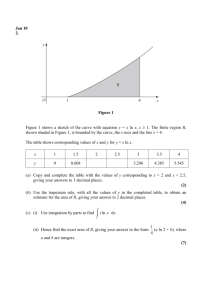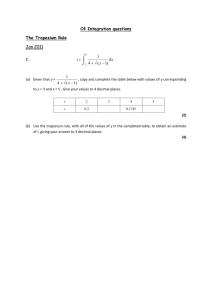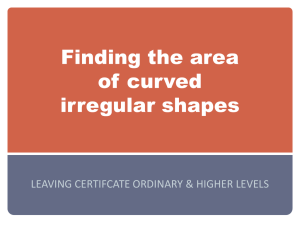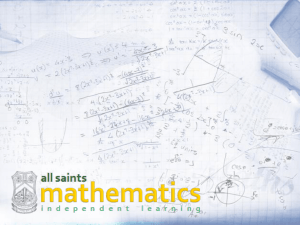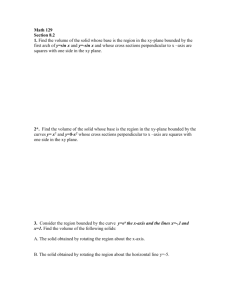C4 Chapter 6 - Integration Exam Questions - Trapezium
advertisement
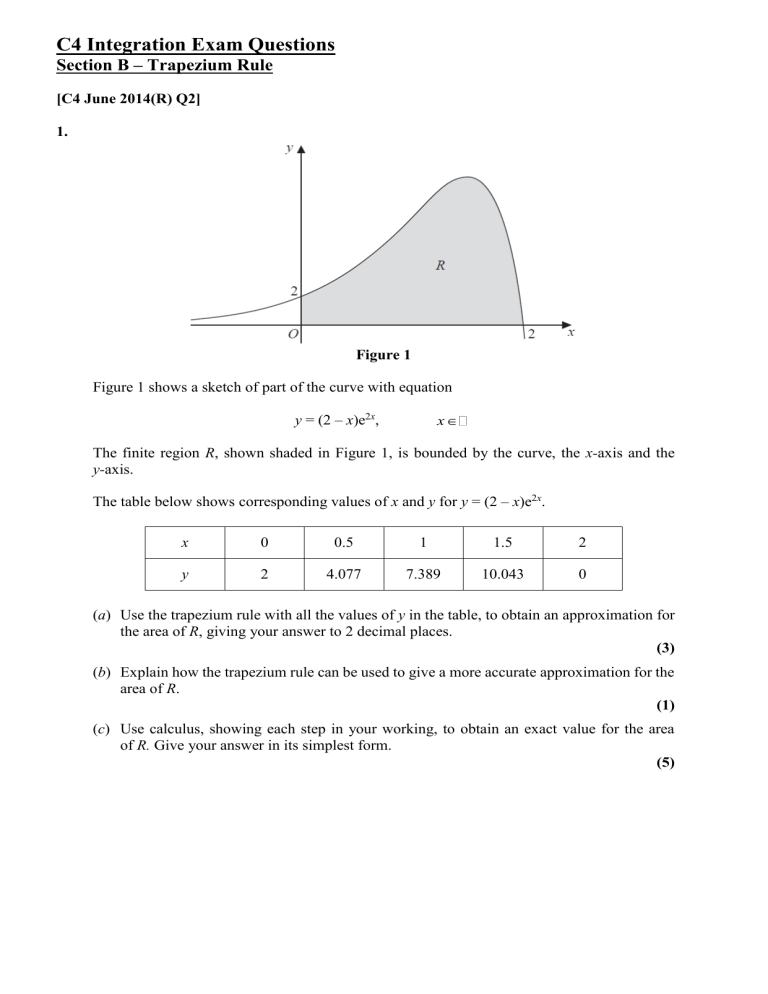
C4 Integration Exam Questions Section B – Trapezium Rule [C4 June 2014(R) Q2] 1. Figure 1 Figure 1 shows a sketch of part of the curve with equation x y = (2 – x)e2x, The finite region R, shown shaded in Figure 1, is bounded by the curve, the x-axis and the y-axis. The table below shows corresponding values of x and y for y = (2 – x)e2x. x 0 0.5 1 1.5 2 y 2 4.077 7.389 10.043 0 (a) Use the trapezium rule with all the values of y in the table, to obtain an approximation for the area of R, giving your answer to 2 decimal places. (3) (b) Explain how the trapezium rule can be used to give a more accurate approximation for the area of R. (1) (c) Use calculus, showing each step in your working, to obtain an exact value for the area of R. Give your answer in its simplest form. (5) [C4 Jan 2014(I) Q4] 2. Figure 1 Figure 1 shows a sketch of part of the curve with equation y 4e x . 3 1 3e x The finite region R, shown shaded in Figure 1, is bounded by the curve, the x-axis, the line x = –3ln2 and the y-axis. The table below shows corresponding values of x and y for y x –3ln2 y 2.1333 –2ln2 4e x . 3 1 3e x –ln2 0 1.0079 0.6667 (a) Complete the table above by giving the missing value of y to 4 decimal places. (1) (b) Use the trapezium rule, with all the values of y in the completed table, to obtain an estimate for the area of R, giving your answer to 2 decimal places. (3) (c) (i) Using the substitution u = 1 + 3e–x, or otherwise, find 4e x dx 3 1 3e x (5) (ii) Hence find the value of the area of R. (2) [C4 June 2013 Q3] 3. Figure 1 Figure 1 shows the finite region R bounded by the x-axis, the y-axis, the line x = and the 2 curve with equation 1 y = sec x , 2 0≤x≤ 2 1 The table shows corresponding values of x and y for y = sec x . 2 x 0 6 y 1 1.035276 3 2 1.414214 (a) Complete the table above giving the missing value of y to 6 decimal places. (1) (b) Using the trapezium rule, with all of the values of y from the completed table, find an approximation for the area of R, giving your answer to 4 decimal places. (3) Region R is rotated through 2π radians about the x-axis. (c) Use calculus to find the exact volume of the solid formed. (4) [C4 June 2013(R) Q5] 4. Figure 1 1 Figure 1 shows part of the curve with equation x 4te 3 t 3 . The finite region R shown shaded in Figure 1 is bounded by the curve, the x-axis, the t-axis and the line t = 8. (a) Complete the table with the value of x corresponding to t = 6, giving your answer to 3 decimal places. t 0 2 4 x 3 7.107 7.218 6 8 5.223 (1) (b) Use the trapezium rule with all the values of x in the completed table to obtain an estimate for the area of the region R, giving your answer to 2 decimal places. (3) (c) Use calculus to find the exact value for the area of R. (6) (d) Find the difference between the values obtained in part (b) and part (c), giving your answer to 2 decimal places. (1) [C4 Jan 2013 Q4] 5. Figure 1 x . The finite region R, 1 x shown shaded in Figure 1, is bounded by the curve, the x-axis, the line with equation x = 1 and the line with equation x = 4. Figure 1 shows a sketch of part of the curve with equation y = (a) Copy and complete the table with the value of y corresponding to x = 3, giving your answer to 4 decimal places. (1) x 1 2 y 0.5 0.8284 3 4 1.3333 (b) Use the trapezium rule, with all the values of y in the completed table, to obtain an estimate of the area of the region R, giving your answer to 3 decimal places. (3) (c) Use the substitution u = 1 + x, to find, by integrating, the exact area of R. (8) [C4 June 2012 Q7] 6. Figure 3 1 Figure 3 shows a sketch of part of the curve with equation y = x 2 ln 2x. The finite region R, shown shaded in Figure 3, is bounded by the curve, the x-axis and the lines x = 1 and x = 4. (a) Use the trapezium rule, with 3 strips of equal width, to find an estimate for the area of R, giving your answer to 2 decimal places. (4) (b) Find x 2 ln 2 x dx . 1 (4) (c) Hence find the exact area of R, giving your answer in the form a ln 2 + b, where a and b are exact constants. (3) [C4 Jan 2012 Q6] 7. Figure 3 shows a sketch of the curve with equation y = 2 sin 2 x , 0x . 2 (1 cos x) The finite region R, shown shaded in Figure 3, is bounded by the curve and the x-axis. The table below shows corresponding values of x and y for y = x 0 y 0 8 2 sin 2 x . (1 cos x) 4 3 8 2 1.17157 1.02280 0 (a) Complete the table above giving the missing value of y to 5 decimal places. (1) (b) Use the trapezium rule, with all the values of y in the completed table, to obtain an estimate for the area of R, giving your answer to 4 decimal places. (3) (c) Using the substitution u = 1 + cos x, or otherwise, show that 2 sin 2 x dx = 4 ln (1 + cos x) – 4 cos x + k, (1 cos x) where k is a constant. (5) (d) Hence calculate the error of the estimate in part (b), giving your answer to 2 significant figures. (3) [C4 June 2011 Q4] 8. Figure 2 Figure 2 shows a sketch of the curve with equation y = x3 ln (x2 + 2), x 0. The finite region R, shown shaded in Figure 2, is bounded by the curve, the x-axis and the line x = 2. The table below shows corresponding values of x and y for y = x3 ln (x2 + 2). x 0 y 0 2 4 2 2 3 2 4 0.3240 2 3.9210 (a) Complete the table above giving the missing values of y to 4 decimal places. (2) (b) Use the trapezium rule, with all the values of y in the completed table, to obtain an estimate for the area of R, giving your answer to 2 decimal places. (3) (c) Use the substitution u = x2 + 2 to show that the area of R is 4 1 (u 2) ln u du . 2 2 (4) (d) Hence, or otherwise, find the exact area of R. (6) [C4 Jan 2011 Q7] 5 1 I= dx . 2 4 ( x 1) 9. 1 , copy and complete the table below with values of y 4 ( x 1) corresponding to x = 3 and x = 5 . Give your values to 4 decimal places. (a) Given that y = x 2 y 0.2 3 4 5 0.1745 (2) (b) Use the trapezium rule, with all of the values of y in the completed table, to obtain an estimate of I, giving your answer to 3 decimal places. (4) (c) Using the substitution x = (u − 4)2 + 1, or otherwise, and integrating, find the exact value of I. (8) [C4 June 2010 Q1] 10. Figure 1 shows part of the curve with equation y = √(0.75 + cos2 x). The finite region R, shown shaded in Figure 1, is bounded by the curve, the y-axis, the x-axis and the line with equation x = . 3 (a) Copy and complete the table with values of y corresponding to x = x 0 y 1.3229 12 1.2973 6 4 and x = . 6 4 3 1 (2) (b) Use the trapezium rule (i) with the values of y at x = 0, x = and x = to find an estimate of the area of R. 6 3 Give your answer to 3 decimal places. (ii) with the values of y at x = 0, x = 12 , x= ,x= and x = to find a further estimate 6 4 3 of the area of R. Give your answer to 3 decimal places. (6) [C4 Jan 2010 Q2] 11. Figure 1 shows a sketch of the curve with equation y = x ln x, x 1. The finite region R, shown shaded in Figure 1, is bounded by the curve, the x-axis and the line x = 4. The table shows corresponding values of x and y for y = x ln x. x 1 1.5 y 0 0.608 2 2.5 3 3.5 4 3.296 4.385 5.545 (a) Copy and complete the table with the values of y corresponding to x = 2 and x = 2.5, giving your answers to 3 decimal places. (2) (b) Use the trapezium rule, with all the values of y in the completed table, to obtain an estimate for the area of R, giving your answer to 2 decimal places. (4) (c) (i) Use integration by parts to find x ln x dx . (ii) Hence find the exact area of R, giving your answer in the form a and b are integers. 1 (a ln 2 + b), where 4 (7) [C4 June 2009 Q2] 12. Figure 1 Figure 1 shows the finite region R bounded by the x-axis, the y-axis and the curve with equation 3 x y = 3 cos , 0 x . 2 3 x The table shows corresponding values of x and y for y = 3 cos . 3 x 0 3 8 3 4 y 3 2.77164 2.12132 9 8 3 2 0 (a) Copy and complete the table above giving the missing value of y to 5 decimal places. (1) (b) Using the trapezium rule, with all the values of y from the completed table, find an approximation for the area of R, giving your answer to 3 decimal places. (4) (c) Use integration to find the exact area of R. (3) [C4 June 2008 Q1] 13. Figure 1 2 Figure 1 shows part of the curve with equation y = e 0.5 x . The finite region R, shown shaded in Figure 1, is bounded by the curve, the x-axis, the y-axis and the line x = 2. (a) Copy and complete the table with the values of y corresponding to x = 0.8 and x = 1.6. x 0 0.4 y e0 e0.08 0.8 1.2 1.6 e0.72 2 e2 (1) (b) Use the trapezium rule with all the values in the table to find an approximate value for the area of R, giving your answer to 4 significant figures. (3) [C4 Jan 2008 Q1] 14. Figure 1 The curve shown in Figure 1 has equation ex(sin x), 0 x . The finite region R bounded by the curve and the x-axis is shown shaded in Figure 1. (a) Copy and complete the table below with the values of y corresponding to x = , giving your answers to 5 decimal places. 2 and x = 4 x 0 y 0 4 2 3 4 8.87207 0 (2) (b) Use the trapezium rule, with all the values in the completed table, to obtain an estimate for the area of the region R. Give your answer to 4 decimal places. (4) [C4 June 2007 Q7] 15. Figure 1 shows part of the curve with equation (tan x). The finite region R, which is bounded by the curve, the x-axis and the line x = , is shown shaded in Figure 1. 4 (a) Given that y = (tan x), copy and complete the table with the values of y 3 corresponding to x = , and , giving your answers to 5 decimal places. 16 8 16 x 0 y 0 16 8 3 16 4 1 (3) (b) Use the trapezium rule with all the values of y in the completed table to obtain an estimate for the area of the shaded region R, giving your answer to 4 decimal places. (4) The region R is rotated through 2 radians around the x-axis to generate a solid of revolution. (c) Use integration to find an exact value for the volume of the solid generated. (4) [C4 Jan 2007 Q8] 5 I = e (3 x 1) dx . 0 16. (a) Given that y = e(3x + 1), copy and complete the table with the values of y corresponding to x = 2, 3 and 4. x 0 1 y e1 e2 2 3 4 5 e4 (2) (b) Use the trapezium rule, with all the values of y in the completed table, to obtain an estimate for the original integral I, giving your answer to 4 significant figures. (3) b (c) Use the substitution t = (3x + 1) to show that I may be expressed as kte t dt , giving a the values of a, b and k. (5) (d) Use integration by parts to evaluate this integral, and hence find the value of I correct to 4 significant figures, showing all the steps in your working. (5) [C4 June 2006 Q6] 17. Figure 3 y O 1 x Figure 3 shows a sketch of the curve with equation y = (x – 1) ln x, x > 0. (a) Copy and complete the table with the values of y corresponding to x = 1.5 and x = 2.5. x 1 y 0 1.5 2 ln 2 2.5 3 2 ln 3 (1) 3 Given that I = ( x 1) ln x dx , 1 (b) use the trapezium rule (i) with values at y at x = 1, 2 and 3 to find an approximate value for I to 4 significant figures, (ii) with values at y at x = 1, 1.5, 2, 2.5 and 3 to find another approximate value for I to 4 significant figures. (5) (c) Explain, with reference to Figure 3, why an increase in the number of values improves the accuracy of the approximation. (1) 3 (d) Show, by integration, that the exact value of ( x 1) ln x dx is 1 3 2 ln 3. (6) [C4 Jan 2006 Q2] 18. (a) Given that y = sec x, complete the table with the values of y corresponding to x = and . 4 x 0 y 1 16 8 3 16 16 8 , 4 1.20269 (2) (b) Use the trapezium rule, with all the values for y in the completed table, to obtain an 4 estimate for sec x dx . Show all the steps of your working and give your answer to 0 4 decimal places. (3) 4 The exact value of sec x dx is ln (1 + 2). 0 (c) Calculate the % error in using the estimate you obtained in part (b). (2) [C4 June 2005 Q5] 19. Figure 1 y R 0 0.2 0.4 0.6 0.8 1 x Figure 1 shows the graph of the curve with equation x 0. y = xe2x, The finite region R bounded by the lines x = 1, the x-axis and the curve is shown shaded in Figure 1. (a) Use integration to find the exact value of the area for R. (5) (b) Complete the table with the values of y corresponding to x = 0.4 and 0.8. x 0 0.2 y = xe2x 0 0.29836 0.4 0.6 1.99207 0.8 1 7.38906 (1) (c) Use the trapezium rule with all the values in the table to find an approximate value for this area, giving your answer to 4 significant figures. (4) Solutions Question 1 Question 2 Question 3 Question 4 Question 5 Question 6 Question 7 Question 8 Question 9 Question 10 Question 11 Question 12 Question 13 Question 14 Question 15 Question 16 Question 17 Question 18 Question 19
